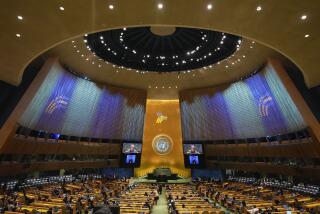A Freeze-Frame for Arms Control : Next Move Awaits Personal Input by Reagan, Gorbachev
- Share via
The INF treaty signed at the Washington summit last December was almost certainly the high-water mark for nuclear arms control during the Reagan Administration. Five months later at the Moscow summit, no progress was made on any of the three critical issues that must be resolved before concluding a strategic arms reduction (START) agreement.
At least two of those issues require personal decisions by President Reagan or General Secretary Mikhail S. Gorbachev. So, unless a powerful back channel exists in which negotiations at the very highest level can be conducted, there is little hope for reducing long-range nuclear weapons in this Administration.
The three fissures that have not been bridged are these:
- There is no agreement, even in principle, on ways to verify limits on sea-launched cruise missiles (SLCMs); neither is there an agreement that SLCMs can be treated outside the basic START structure, just as mobile ICBMs and all cruise missiles were under the SALT II treaty.
- The missile warning radar at Krasnoyarsk violates the 1972 ABM treaty. The Soviets have not offered to destroy the facility; neither is there any indication that the United States is prepared to accept the Soviet moratorium on completion of the radar as a satisfactory solution.
- And, finally, the United States has refused to allow any limitations whatsoever to be imposed on the Strategic Defense Initiative.
The cruise missile issue is a technical one; a compromise could be reached at the ministerial level, or even in the negotiations in Geneva. Seals and tags on the weapons themselves, coupled with the kind of production monitoring arrangements in the INF treaty, would demonstrate to each side that nuclear-tipped missiles have not clandestinely replaced conventionally armed ones. Higher technical barriers have been overcome in other arms agreements.
The prestige of the two leaders and the basic national policies of their countries are at stake in the other issues. Therefore, solutions for the problems of Krasnoyarsk and SDI almost certainly require personal decisions at the very top.
Within the American political system, the START treaty, SDI and the ABM treaty are indissolubly linked. It will be hard enough to obtain Senate advice and consent to a START treaty if a critical part of its infrastructure has been openly violated by the Soviet Union. It will be harder still to ratify the treaty if the President cannot certify that he is satisfied that the Soviet Union has returned to compliance.
It now appears that the director of the Arms Control and Disarmament Agency, retired Army Gen. William Burns, will lead a small delegation to Geneva to conduct the required review of the ABM treaty. Burns may well be under instructions to demand that the radar at Krasnoyarsk be destroyed. If the Soviets refuse, the United States may declare them to be in “material breach” of the treaty, leaving President Reagan free to order a violation of the treaty in compensation. That could take the form of carrying out tests of SDI components in forbidden ways, destroying hopes for strategic arms reductions.
The Soviets will not be persuaded to demolish their mistake at Krasnoyarsk without the United States’ agreement to adhere to the ABM treaty as Richard M. Nixon and Leonid I. Brezhnev understood it.
The problem of the radar at Krasnoyarsk thus dovetails neatly with the Soviet demand for limits on SDI development, testing and deployment. The Soviets are right in insisting that they cannot agree to a treaty requiring them to dismantle half of their strategic missiles while allowing the United States to devalue those that remain by building defenses against them. START must contain pledges to adhere to the ABM treaty. And the Senate will not ratify a new treaty that obliges the United States to abide by the ABM treaty so long as the Krasnoyarsk sore festers.
The Washington summit ended with a communique that was ambiguous enough on SDI to permit a START treaty to be completed; essentially, the next U.S. Administration would be left to make the final decision. Almost immediately after Gorbachev left Washington, however, President Reagan started to back away from the deal. In Moscow, the cat was wholly stuffed back into the bag.
The President alone can give the signal to make further progress, and this President has shown no willingness to play the SDI card, even to clinch a deal on START. His experience as a labor negotiator for movie stars might have led him to delay any concessions until the end game--but the Reagan Administration is already in its end game.
The optimism about serious arms reductions that flourished before the Moscow summit, the hopes contained in the promises of the two leaders, now seem to have withered. It is disappointing, but there is still time for the two leaders to take the personal decisions needed to make a START treaty possible. Mikhail Gorbachev must eliminate the Krasnoyarsk violation, now as much a question of prestige as substance; Ronald Reagan must assure the Soviets that the United States will observe the ABM treaty, the essential requirement for arms control.
More to Read
Sign up for Essential California
The most important California stories and recommendations in your inbox every morning.
You may occasionally receive promotional content from the Los Angeles Times.













